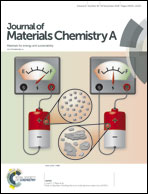Identifying the origin and contribution of pseudocapacitive sodium ion storage in tungsten disulphide nanosheets for application in sodium-ion capacitors†
Abstract
Sodium (Na)-ion capacitors are emerging as one of the most promising hybrid devices for next generation electrochemical energy storage systems because of their abundant resources, and environmentally friendly nature as well as the potential integration of Na-ion batteries with high energy density and electrochemical capacitors with high power density. However, the practical application of Na-ion capacitors is severely hampered by the sluggish redox kinetics in anodes. To overcome this obstacle, the most effective approach is to develop a pseudocapacitive anode material for Na ion storage. Here, we demonstrate a predominant pseudocapacitive contribution for Na ion storage in tungsten disulphide (WS2) nanosheets within the potential window of 1–3 V vs. Na/Na+. Particularly, the root cause of pseudocapacitive Na ion storage in WS2 nanosheets was systematically investigated by operando X-ray diffraction (XRD), ex situ synchronous radiation tests and density functional theory (DFT) simulations. This work may provide a fundamental insight into the development of pseudocapacitive materials for electrochemical energy storage systems.



 Please wait while we load your content...
Please wait while we load your content...